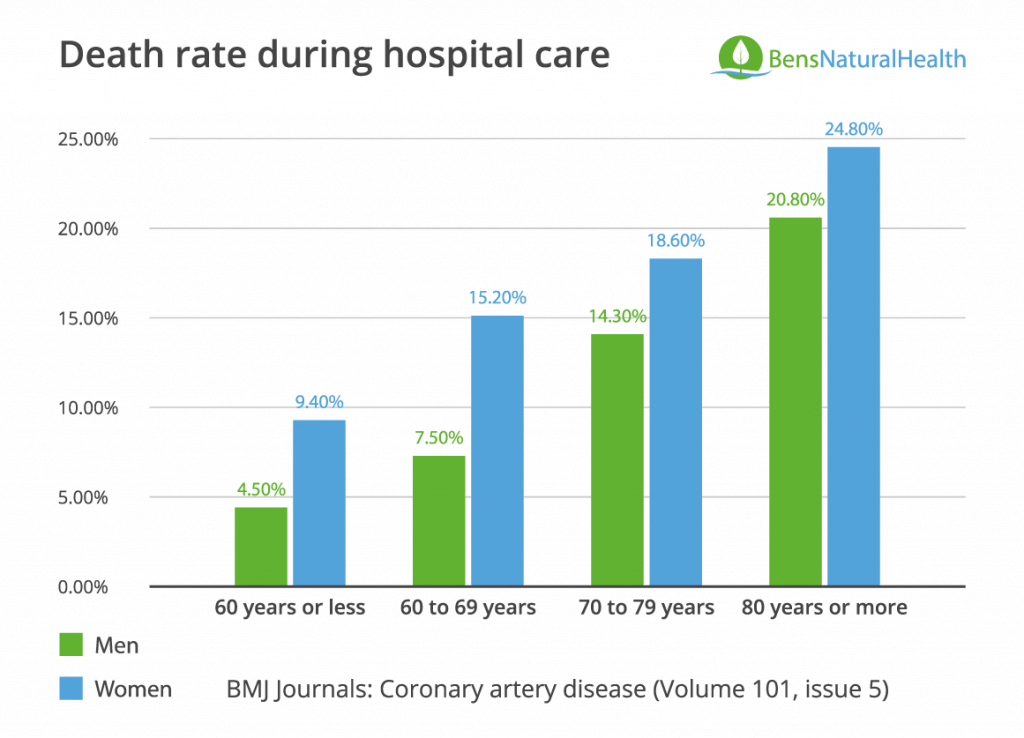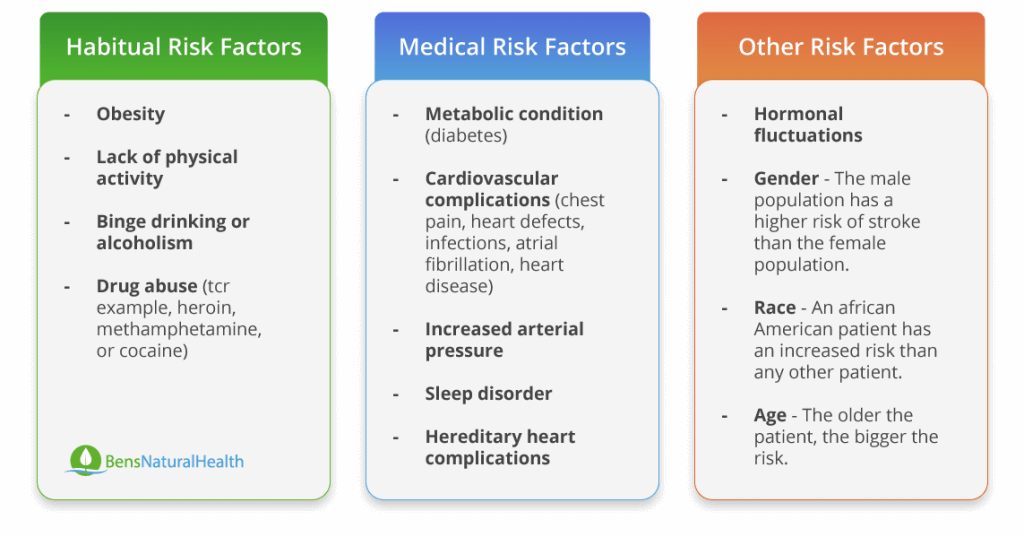Stroke is a serious health concern among the general population.
It’s considered a leading cause for permanent disability and 5th leading cause of death. In fact, over 140,000 people lose their life to stroke in the U.S.
Luckily, some of these attacks could be avoided. According to the CDC, around 4 in 5 strokes are avoidable. Therefore, men need to take the right precautions to live a longer and healthier life.
This is a detailed guideline on how to pinpoint some of the most prevalent signs of stroke in men, including tips on ways to react in case of an emergency.
Get Your FREE Eye Health Diet Plan
- Nine most important vitamins for eye health
- How to naturally protect and improve your eye health as you age
- Developed exclusively by our medical doctor
Is Stroke a Widespread Issue in Men?
Every 4 minutes, a person dies of a stroke in the U.S.
Sometimes people underestimate the impact of heart problems. Many think of them as a short-term risk. While, in reality, they could have some severe repercussions on overall health. Especially the male population.
Stroke risk is 30% greater in men than women. Also, more men under the age of 44 seek medical care for ischemic stroke. The only difference is the severity of the heart condition.

Stroke causes more complex issues in the female body, so the fatality risk is much higher. It is more frequent in men but deadlier in women.
The reason for that is relatively simple. The female system is more at risk of having high blood pressure. Also, with each birth control and pregnancy, they intensify their likelihood of stroke.
What most people don’t realize is that men are prone to age-related heart problems. About 47% of men are taking blood pressure medicine. But, not everyone controls their arterial pressure properly. Experts believe their negligence has a lot to do with awareness.
For instance, women pay more attention to their nutrition. They prefer to consult with nutritionists and eat healthily. At the same time, men focus primarily on high-sucrose foods, alcohol, protein, and quick meals.
Although stroke is not as deadly for men as it is in women, the male population still has to pay close attention to the underlying symptoms.
What Could Possibly Trigger a Stroke?
A stroke is quite like a heart attack. However, it directly impacts the central nervous system, capillaries, veins, and arteries. Not the heart.
Hypertension is often the cause of this heart problem. But, other risk factors affect the incidence, like hormone exposure and age. A stroke happens the moment the blood supply is cut off from the brain.
This obstructs the brain tissue from getting any nutrients or oxygen. That’s why the brain cells can die in just a couple of minutes. To avoid serious complications and risk brain damage, you need to act quickly. That’s why knowing the triggers can come in handy.
There are two main stroke triggers:
- Ischemic stroke (blocked artery)
- Hemorrhagic stroke (splits or leaks of the blood vessels)
Certain individuals experience just a temporary blood flow disruption. This is what experts call TIA or transient ischaemic attack. When that happens, patients don’t experience any permanent symptoms. They just need proper stroke care to get their health under control.
Ischemic Stroke
Ischaemic stroke is a typical and widespread heart problem. When the artery becomes blocked or narrow, that’s when this stroke can happen. Without a properly functioning artery, the heart and body won’t get enough oxygen.
Debris, fatty deposits, or blood clots can get inside the carotid artery and block the vessels to the brain. Doctors will need to take care of the blood clot as soon as possible. The moment the clot is removed, the blood pressure can get back to normal.
People can also experience an acute ischemic stroke. The blood flow becomes reduced, and a clot starts to form in the brain. Because of the acute stroke, the brain artery experiences a sudden blockage. This creates intense and sharp leg, arm, or face pain.
Hemorrhagic Stroke
Hemorrhagic stroke occurs due to a blood vessel rupture or a leak. The bigger the trauma, the higher the risk. For example, unregulated blood pressure control and blood thinner overtreatment can elevate the risk of this kind of stroke.
When it does happen, the leakage adds pressure to the brain. The brain cells become injured. That’s why the brain can’t function normally. To avoid a severe brain injury, doctors need to control the spillage and stop the leak.
TIA (Transient Ischemic Attack)
This is what experts call a ministroke. It’s identical to a stroke, but without the permanent damage. For most stroke patients, it can last about 5 min. It happens as a result of blockages in the blood vessels that interrupt the flow of blood to the brain.
Typical Signs and Symptoms of a Stroke in Men
There are a couple of obvious symptoms to help you recognize a stroke. Take a look at the common stroke symptoms below. These signs of a stroke in men include:
- Sudden loss of feeling in the face, legs, or arms – A stroke victim usually develops paralysis, weakness, or numbness in certain parts of their bodies. It starts with one side. If you suspect someone to be having a stroke, ask them to raise both their arms over the head. If they can’t do that, it could mean they are experiencing a heart problem. The sudden numbness in the face is also a clear indicator. Their left or right side of the mouth could droop when they are trying to smile.
- Black or blurry vision – It is normal for a patient to experience vision impairment when suffering from a stroke. Their vision can turn blurry in both eyes, which will make it difficult to discern figures.
- Loss of balance – Trouble walking is a usual symptom. That sudden onset of coordination loss and dizziness forces a patient to lose their balance.
- Slurred speech – Speech impairment is another one of those well-known stroke symptoms. Patients will have trouble understanding speech and using words. They will be extremely confused as to what is happening with their body.
- Sudden severe headache – Severe headache can appear in an instant. They are often followed by nausea, dizziness, and vomiting.
Possible Risk Factors People Should Be Aware Of
There are numerous risk factors associated with stroke. Many of them can be prevented. What’s important is that you learn to recognize them and try to manage them. Take a look at the table below. It can help you figure out each risk that can provoke a stroke.

How to Save a Patient In Case of Stroke?
When a patient is experiencing a stroke, each second matters. Everything you do could save their life. Since this health issue directly attacks the brain, you need to act quickly. Therefore, recognizing the signs of a stroke in men and women is vital to ensure early treatment.
Here are a few steps that will be useful.
Do a FAST Stroke Test
Observe the patient’s stroke warning signs in men and women with a FAST test. This test relies on four simple steps:
- F = Facial Changes – Ask the patient to smile. Look for anything that might affect their facial structure. Stroke can cause one side of the face to droop.
- A = Arms – Instruct the patient to lift both their arms as much as possible. If one drifts downwards, it is a serious issue.
- S = Slurry Speech – Stroke makes it hard for people to talk properly. Try to notice if there is a change in the way they speak.
- T = Time to Call for Help – When a person has all of these symptoms, call an ambulance right away.
Be Specific
Having a witness can be immensely helpful for treating stroke survivors. Doctors will need to know when the stroke symptoms began, what could be the cause of it, or any other information that may prove useful. So, try to note the exact moment that the person experienced these health issues.
Share any personal information about a hereditary disease, allergic reactions, or other health issues the doctor should know. This will help them better treat patients. Depending on their health state, patients can receive tPA (a “clot-busting” drug) to help them cope better.
Do CPR If Needed
The majority of stroke patients don’t need CPR. However, if the person losses conciseness or has trouble breathing, CPR can prove useful.
What Are the Treatment Options?
The individuals affected are taken to an emergency room for treatment. The primary goal will be to drop the risk of probable brain injury and renew blood flow. Doctors will determine the best care based on the type of stroke.
For a blocked artery, they will use:
- IV injection
- Endovascular therapy
- tPA
- Angioplasty
- Carotid endarterectomy
While for hemorrhagic stroke or splits or leaks of the blood vessels, they will rely on:
- Surgery
- Blood-thinning drugs
- AVM removal
- Endovascular embolization (coiling)
- SRS (Stereotactic radiosurgery)
Outlook
Typically, men heal faster from a stroke. They are also less prone to mental impairment, stroke-induced disability, and fatigue. Studies show this might be because of the depressive and physical activity symptoms before the stroke.
But, it is still possible for stroke survivors to live long and happy lives. With proper stroke rehabilitation and adequate lifestyle changes, they can put their health back on track.
Avoiding Stroke in the Future
Patients need to treat, manage, and avoid any conditions that make them vulnerable to stroke. That includes hypertension, high cholesterol, obesity, or atrial fibrillation. This can reduce their stroke risk factor in the long-run.
Explore More








